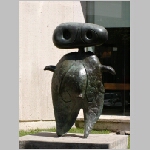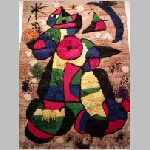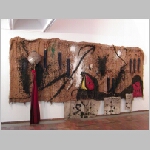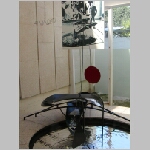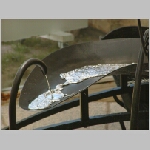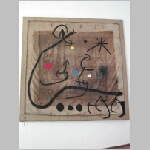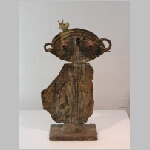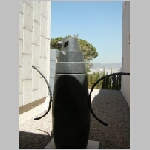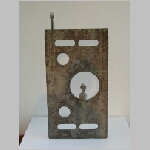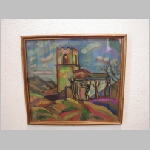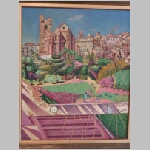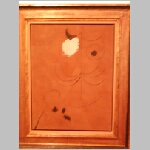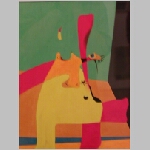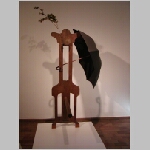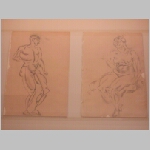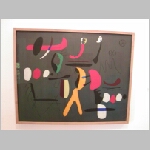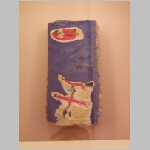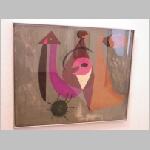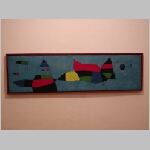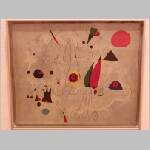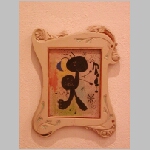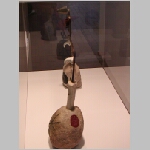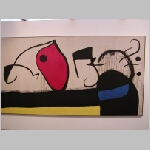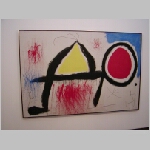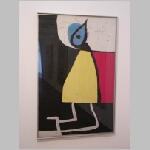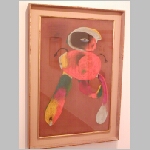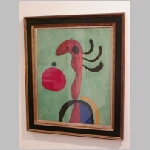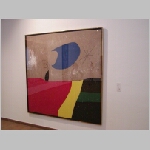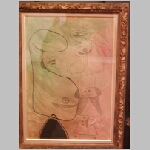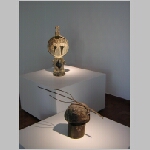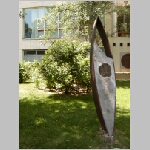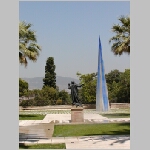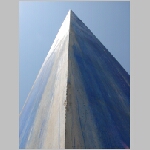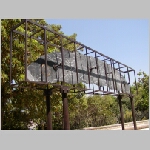Joan Miró (1893–1983) was a groundbreaking Spanish Catalan painter,
sculptor, and ceramicist whose work blended abstract art with Surrealist
fantasy. His distinctive style, characterized by playful yet profound
symbolism, made him one of the most influential artists of the 20th
century. Below is a detailed overview of his life, art, and legacy:
Key Aspects of Joan Miró's Life and Art
1. Early Life and
Influences
Born on April 20, 1893, in Barcelona, Spain, Miró grew up
in a family of artisans—his father was a watchmaker and goldsmith, which
influenced his meticulous craftsmanship 15.
Initially pressured
to pursue business, he suffered a nervous breakdown while working as a
clerk, leading him to fully commit to art. He studied at the Barcelona
School of Fine Arts and later under Francisco Galí, who encouraged his
experimental approach 13.
Early works (1910s) reflected Fauvist
and Cubist influences, with bold colors and geometric forms inspired by
Paul Cézanne and Vincent van Gogh 57.
2. Surrealism and Paris
Years
In 1920, Miró moved to Paris, where he mingled with avant-garde
artists like Pablo Picasso and André Breton. Though he never fully
integrated into the Surrealist group, he signed their manifesto in 1924
and became known for his dreamlike, biomorphic forms 28.
Key
works from this period:
The Farm (1921–22): A detailed, almost
hallucinatory depiction of his family’s countryside home, later owned by
Ernest Hemingway 15.
Harlequin’s Carnival (1924–25): A whimsical,
chaotic scene blending abstract and figurative elements 2.
Dog
Barking at the Moon (1926): A minimalist yet evocative composition
featuring a ladder, a dog, and a crescent moon, symbolizing longing and
escape 24.
3. Symbolism and Iconography
Miró’s art is filled
with recurring symbols:
Stars and planets: Represent dreams and
the unconscious 48.
Birds: Bridges between earth and sky, reality
and imagination 4.
Ladders: Symbolize escape or transcendence,
reflecting his anxiety during the Spanish Civil War 45.
Eyes and
feet: Ground figures in reality, while other elements drift into
abstraction 4.
Vaginas: A recurring motif in his depictions of
women, though less overtly sexual than Picasso’s 4.
4. Political
and Social Engagement
Though not overtly political, Miró responded to
the Spanish Civil War (1936–39) with works like The Reaper, a mural for
the Spanish Republican Pavilion in Paris (1937), conveying protest and
despair 15.
During World War II, he retreated to Spain and
created the Constellations series (1940–41), small, poetic works imbued
with celestial symbolism 18.
5. Experimentation with Mediums
Ceramics: Collaborated with Josep Llorens Artigas from the 1940s,
creating monumental works like the UNESCO murals The Wall of the Sun and
The Wall of the Moon (1958) 58.
Sculpture: In the 1960s–70s, he
assembled found objects into playful sculptures, such as Woman and Bird
(1983), a 22-meter-high ceramic piece in Barcelona 87.
Printmaking: Produced over 1,000 lithographs, making his art accessible
to broader audiences 35.
6. Later Years and Legacy
In his
final decades, Miró embraced radical simplicity, as seen in the Blue
I–III triptych (1961), where sparse forms float in vast blue fields 8.
He founded the Joan Miró Foundation in Barcelona (1975), a museum
dedicated to his work and contemporary art 87.
Died on December
25, 1983, in Palma de Mallorca, leaving behind a prolific oeuvre: ~2,000
paintings, 500 sculptures, and 5,000 drawings 68.
Fun Facts About
Miró
He painted The Farm while starving in Paris, trading it for
meals with Hemingway 12.
In his 80s, he began finger-painting and
even burned some of his canvases as a creative act 68.
His World
Trade Center Tapestry (1974) was destroyed in the 9/11 attacks 5.
A quiet, disciplined man, he dressed in business suits and rejected
the "bohemian artist" stereotype 36.
Why Miró Matters
Miró’s
work transcends labels, merging childlike spontaneity with sophisticated
abstraction. His influence extends to Abstract Expressionists (like
Jackson Pollock) and Color Field painters, while his symbols—stars,
birds, ladders—remain iconic. As he once said, "I want to assassinate
painting"—challenging conventions to create a universe of poetic freedom
25.
For deeper exploration, visit the Joan Miró Foundation or the
Fundació Pilar i Joan Miró in Mallorca.
New chat |
Joan Miró war ein bedeutender katalanischer Maler, Bildhauer und
Grafiker, der am 20. April 1893 in Barcelona geboren wurde und am 25.
Dezember 1983 in Palma de Mallorca starb. Er gilt als einer der
führenden Vertreter des Surrealismus und der abstrakten Kunst des 20.
Jahrhunderts.
Stil und Einfluss
Mirós Werke zeichnen sich
durch leuchtende Farben, organische Formen und eine poetische
Symbolsprache aus. Seine Kunst verbindet Elemente des Surrealismus mit
katalanischer Volkskunst und persönlichen Traumwelten. Er entwickelte
eine eigene Bildsprache mit wiederkehrenden Motiven wie Sternen, Vögeln,
Augen und weiblichen Figuren.
Bedeutende Werke
La Masia (The
Farm) (1921–1922): Ein Gemälde, das Mirós Kindheitserinnerungen an das
Familienanwesen in Mont-roig del Camp einfängt. Es gilt als
Schlüsselwerk seiner frühen Schaffensphase. Er selbst bezeichnete es als
„Zusammenfassung meines gesamten Lebens auf dem Land“ .
El segador (Der Schnitter) (1937): Ein politisches Wandbild, das Miró
für den spanischen Pavillon auf der Weltausstellung 1937 in Paris schuf.
Es zeigt einen katalanischen Bauern in Revolte und ist ein kraftvolles
Symbol des Widerstands gegen den Faschismus. Das Original ging verloren,
aber Fotografien erhalten das Werk .
La terre labourée (The Tilled
Field) (1923–1924): Ein Gemälde, das eine stilisierte Darstellung von
Mirós Familienfarm zeigt. Es gilt als eines seiner ersten
surrealistischen Werke . Museen und Ausstellungen
Fundació Joan Miró
(Barcelona): Gegründet 1975, beherbergt sie die weltweit größte Sammlung
von Mirós Werken. Das Museum liegt auf dem Montjuïc-Hügel und wurde vom
Architekten Josep Lluís Sert entworfen. Es umfasst Gemälde, Skulpturen,
Zeichnungen und eine Bibliothek mit über 10.000 Werken .
Fundació Pilar i Joan Miró (Palma de Mallorca): 1992 eröffnet, umfasst
sie über 6.000 Werke des Künstlers, darunter Gemälde, Skulpturen und
Zeichnungen. Das Anwesen umfasst Mirós ehemalige Ateliers und einen
Skulpturengarten .
Aktuelle Entwicklungen
2022: Die Fundació Joan
Miró in Barcelona erhielt eine bedeutende Sammlung von 59 Werken,
darunter Gemälde und Zeichnungen, die von Mirós Familie gestiftet
wurden. Diese Sammlung wurde in der Ausstellung „Miró. El legado más
íntimo“ präsentiert .
The Guggenheim Museums and Foundation
2025: Die Fundació Joan Miró plant eine große Retrospektive zu Ehren des
100. Jahrestages von Mirós „Blauem Triptychon“ (1925), das als eines
seiner Meisterwerke gilt. |
 Safaris
Bergsteigen
Wandern
Inselwandern Weltweit
Safaris
Bergsteigen
Wandern
Inselwandern Weltweit
 Europa
Inselwandern
Europa
Inselwandern
 Städtewandern
Städtewandern
 Paintings
Paintings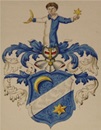 Dirk Rauschenbach
Dirk Rauschenbach
 Safaris
Bergsteigen
Wandern
Inselwandern Weltweit
Safaris
Bergsteigen
Wandern
Inselwandern Weltweit
 Europa
Inselwandern
Europa
Inselwandern
 Städtewandern
Städtewandern
 Paintings
Paintings Dirk Rauschenbach
Dirk Rauschenbach
